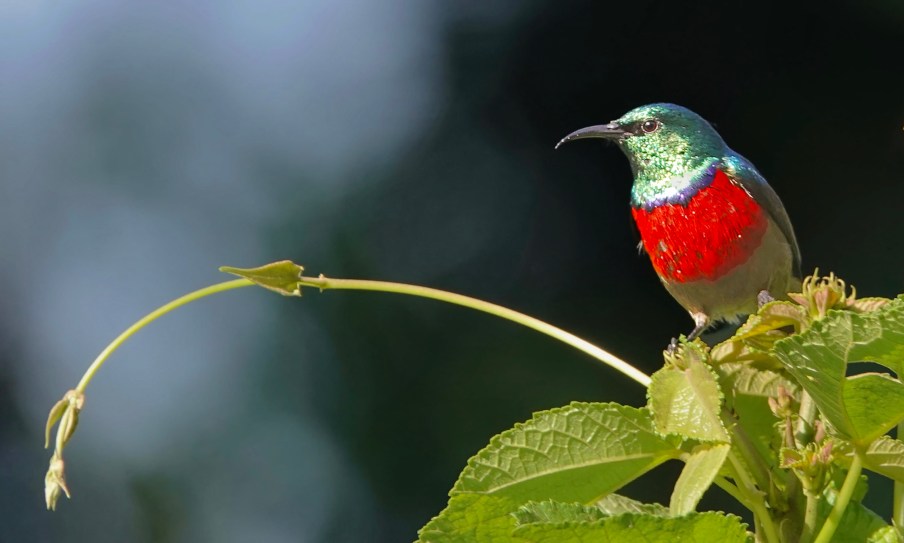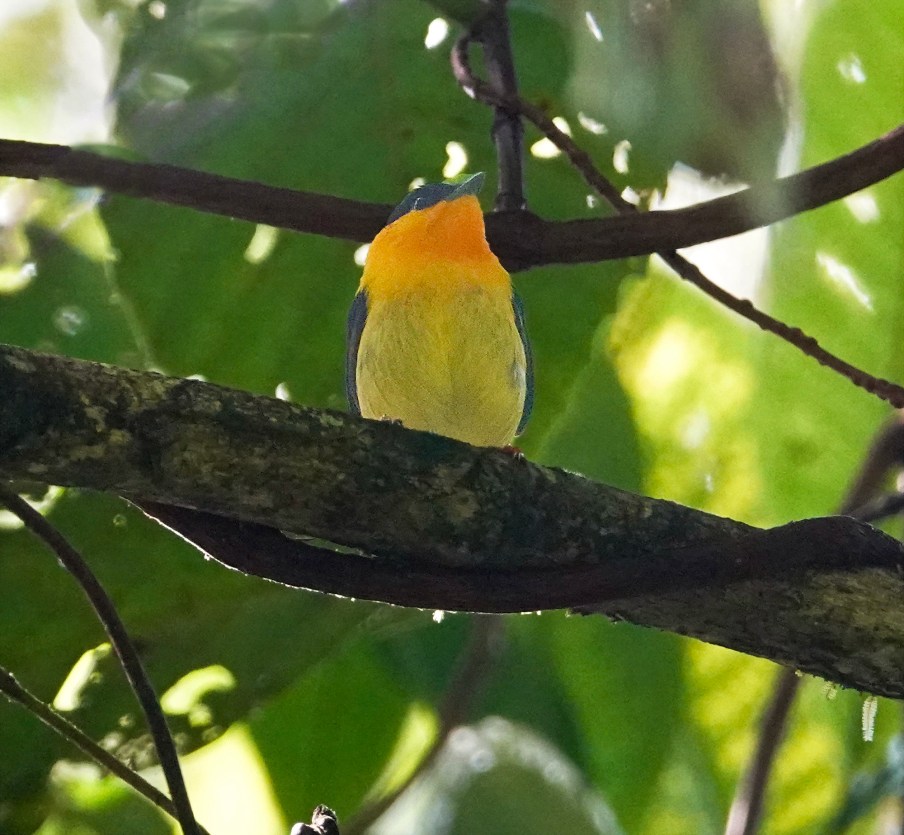Uganda Edition: Sunbird in the sun

Northern Double-collared Sunbird: Bwindi Impenetrable Forest National Park, Uganda, August 2022 — Sunbirds, like this Northern Double-collared, are made for the sun. Such a splendor of color! Again, from the edges of the parking area for the Gorilla Trek at Bwindi, while we waited for the trekkers to come back. This is more of an “art” shot…something for the wall instead of the guide-book. Sony Rx10iv at 591mm equivalent. Program mode with my custom birds and wildlife modifications. Processed in Pixelmator Pro and Apple Photos. ISO 250 @ f4 @ 1/500th.
Orange-collared Manakin

Orange-collared Manakin: Danta Corcovado Lodge, Osa Peninsula, Costa Rica, December 2022 — Though it is not as closely associated with ant swarms as the others I have shared, this Orange-collared Manakin was with the mixed flock. The Orange-collared (this is a male) is endemic to the pacific lowlands of southern Costa Rica and northern Panama. They kind of glow in the darkness of the undergrowth under heavy canopy. Sony Rx10iv at 600mm equivalent. Program mode with my custom birds and wildlife modifications and multi-frame noise reduction. Processed in Pixelmator Pro and Apple Photos. Equivalent ISO 2000 @ f4 @ 1/500th.
Uganda Edition: Black-and-white Shrike-flycatcher
Black-and-white Shrike-flycatcher: Bwindi Impenetrable Forest National Park, Uganda, August 2022 — This is the female of the Black-and-white Shrike-flycatcher, not an uncommon bird in Uganda west of lake Victoria, but rare other places in East Africa. It is, I would say, also uncommon at the elevation where we were in Bwindi, but it is generally seen where we saw it…high in the top of tree or up into the canopy. Sony Rx10iv at 600mm equivalent. Program mode with my custom birds and wildlife modifications. Processed in Pixelmator Photo and Apple Photos. ISO 100 @ f5 and f4 @ 1/1000th.
Carolina Wren! in Kennebunk
Carolina Wren: Kennebunk, Maine, USA — Look who showed up under the feeders on our back deck! Carolina Wrens are not unheard of in Maine, especially at feeders during the early winter, but this is a first for our yard! In fact, most range maps had a little extension up the coast of Maine as far as Portland colored as regular, even breeding, for Carolina Wren, with an area up into southern Canada where they are “rare”. I just don’t think of them as coming that far north, and this is my first, not only for our yard, but for Maine. It showed up a few days ago for a few moments when Carol saw it and was able to describe it well enough so that I knew what it was…but then yesterday, early, it came with the neighborhood mixed feeding flock and was on the deck for long enough for me to get the camera. These shots are through the glass of the deck door. I would love to have one settle in and nest in the yard. Wouldn’t that be something! Sony Rx10iv at 600mm equivalent. Program mode with my custom birds and wildlife modifications. Processed in Pixelmator Pro on the Mac Air. ISO 1600 and 2000 @ f4 @ 1/500th.
Uganda Edition: Northern Puffback
Northern Puffback: Bwindi Impenetrable Forest National Park, Uganda, August 2022 — We must have been very near the maximum elevation for this bird…and I would have said we were higher there in the parking area for the Gorilla Trek in Bwindi. The Puffbacks are bushshrikes, and the Northern is the most common in western Uganda. Sony Rx10iv at 600mm equivalent. Program mode with my custom birds and wildlife modifications. Processed in Pixelmator Photo and Apple Photos. ISO 100 @ f4 @ 1/640th and 1/800th. .
Ant birds! Chestnut-backed and Bicolored
Chestnut-backed and Bicolored Antbird: Danta Corcovado Lodge, Osa Peninsula, Costa Rica, December 2022 — I promised you more birds from the mixed feeding flock attracted to the army ant swarm we found at Danta Corcovado early one morning, and then I got distracted by our backyard birds 🙂 These are two of the birds closely associated with army ant swarms…among the many that are attracted to the insects and small vertebrates that are fleeing from the ants…so closely associated that they have “ant” in their name. They are indeed Antbirds: The male Chestnut-backed Antbird and either a male or female Bicolored Antbird (they have the same plumage, while the female of the Chestnut-backed lacks the black on the chest.) Again, because they are so intent on hunting when you see them, it is often possible to get very close. However, since they are hunting low to the ground in heavy canopy, there is never enough light! Sony Rx10iv at about 580mm equivalent. Program mode with my custom birds and wildlife modifications with multi-frame noise reduction. Processed in Pixelmator Photo and Apple Photos. Equivalent ISO 6400 @ f4 @ 1/100th and 1/80th. (very little light!)
Uganda Edition: Green-headed Sunbird
Female Green-headed Sunbird: Bwindi Impenetrable Forest National Park, Uganda, August 2022 — There were several female Green-headed Sunbirds around the parking area for the Gorilla Trek in Bwindi the day we visited, but we never did see a male. So it goes. At least the females of the the species are among the more colorful female sunbirds. The Green-headed also has much larger range than the Albertine Rift birds we have been looking at…it can be found in the highlands of East Africa as far south as Mozambique and throughout equatorial West Africa. Sony Rx10iv at 591mm equivalent. Program mode with my custom birds and wildlife modifications. Processed in Pixelmator Photo and Apple Photos. ISO 2000 and 800 @ f4 @ 1/500th.
White-breasted Nuthatch

White-breasted Nuthatch: Kennebunk, Maine, January 2023 — While we are on the subject of backyard birds, here is our resident White-breasted Nuthatch. We have a pair that come daily to the feeders on the back deck, year around. So let us take a moment to celebrate White-breasted Nuthatches. 🙂 Sony Rx10iv at 600mm equivalent. Program mode with my custom birds and wildlife modifications. Processed in Pixelmator Pro and Apple Photos. ISO 1000 @ f4 @ 1/500th.
Uganda Edition: Blue-headed Sunbird
Blue-headed Sunbird: Bwindi Impenetrable Forest National Park, Uganda, August 2022 — Another Albertine Rift endemic, from around the parking area at the trailhead for Gorilla Trekking. Gordon, our guide for the morning, and an excellent young guide/birder said, “Oh get this one! Take a photo!” and I did my best. We only saw it for a moment, though it can be fairly common in its restricted range. What a stunner! Sony Rx10iv at 591mm equivalent. Program mode with my custom birds and wildlife modifications. Processed in Pixelmator Pro and Apple Photos. ISO 500 @ f4 @ 1/500th.
Red-bellied Woodpecker
Red-bellied Woodpecker: Kennebunk, Maine, USA, January 2023 — When we first moved to Kennebunk, going on 30 years ago now, and up to a few years ago, a Red-bellied Woodpecker was a rare sighting in our yard. In fact we had probably been here at least 10 years before we saw our first one. Over the past 5 years, the number of sightings has steadily increased, and they have started coming to our back-deck feeding station on a semi-regular basis. We will go a month without seeing one, and then have a month, or a week at least, when they are at the feeder several times a day…I say “they”, but it could be just one…I have yet to see more than one at a time. They are among the most skitterish of our backyard birds. They generally disappear if there is slightest sign of movement in the house, but even at that they seem to be becoming more bold, or more secure. This one allowed me to stand behind the thermopane glass of the deck door, close enough so I had to zoom out to fit the bird in the frame, and take its photo as it used the feeder. Sony Rx10iv at 458mm equivalent. Program mode with my custom birds and wildlife modifications. Processed in Pixelmator Pro and Apple Photos. ISO 1250 @ f4 @ 1/500th.















